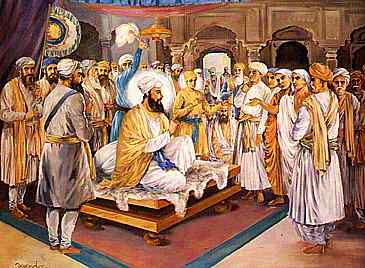Pandit Kirpa Ram
Pandit Kirpa Singh Dutt (d. 1705) was the son of Bhai Aru Ram, a Sarasvat Brahman of Matan, 65 KM east of Srinagar, in Kashmir. Aru Ram had met Guru Har Rai and sought his blessing at the time of the latter's visit to Kashmir in 1660.
A group of Kashmiri Brahmins came to Guru Tegh Bahadar at Anandpur in May 1675 for protection against atrocities of Aurungzeb. Kirpa Ram led this group of Kashmiri Pandits driven to dire straits by State Persecution. They had faced stiff taxes, atrocities, cruelty under Muslim Mughal governor of Kashmir. Honour of their daughters was being lost and they were losing their religion to the fanatic zeal and proletyzation activities of Islamic crusaders.
Iftikhar Khan, governor of Kashmir (1671-75) was a harsh man and was making forcible conversion to Islam. Kashmiri Brahmins asked Guru for a solution. Guru replied "Such activities can only be stopped by a sacrifice of a great person". Just then 8 years old son of Guru Tegh Bahadar, Gobind Rai (Later Gobind Singh) walked into the meeting to find his father lost deep in thoughts. He enquired about the reason. He offered a possible solution by saying "who else is greater then you, O father". Guru Tegh Bahadar knew immediately about his mission and Dharma. He told Kashmiri Brahmins, Go tell Aurungzeb that if they can convert your Guru then you will all become Muslims. Kirpa Ram obliged and Aurungzeb issued a summons for Guru ji.
Guru Tegh Bahadar whose help the visitors sought asked them to go and have it communicated to the Emperor, If he can get (Guru Tegh Bahadur) to convert to Islam, then they would all voluntarily accept conversion. Kirpa Ram and his companions sent to Emperor Aurungzeb a petition to that effect through Zalim Khan, a governor of lahore. Then followed by imperial summons, and Guru Tegh Bahadur's arrest and Martyrdom in Delhi. Shaheedi of Nanak 9 Kirpa Ram returned to Anandpur. Guru Gobind Singh ji from 1675 until 1690 took an extensive courses in Sanskrit, Persian, Arabic, and Punjabi in educating himself.
According to chronicles, Pandit Kirpa Dutt was Guru Gobind Singh's Sanskrit teacher. Guru Gobind Singh contemplated the martyrdom of Guru Arjan Dev (his great grand father) and his father Guru Tegh Bahadur and decided to at Anandpur on March 31st 1699 he created a new order of Saint-soldiers known as the Khalsa. At Anandpur Sahib Pandit Kirpa Ram Dutt became part of the Khalsa, changing his name to Kirpa Singh after taking Khanda Baate da Pahul.
Later that year the forces of the local Rajput Rajas who were alarmed by the rapid changes that Guru Gobind Singh was making in the rigid caste based Hindu religion. Particularly troubled over the growing number of converts from the Hindu and Sikh faiths and angered by the Guru putting a sudden and abrupt end to the converts' historical caste designations (even adopting the Rajputs' traditional name Singh (lion), previously only used by the Rajput warrior caste of Hinduism, sought the help of their Mughal allies to put and end to this new religion which clearly threatened their privileges. The Mughals having lost men in previous battles with the Sikhs were only to glad to attack the fort of Anandpur, and after many months and several defeated attempts to take the city and a long siege, the Sikhs, low on both supplies and ammunition and nearly starved, agreed to abandon the city under a second promise of safe conduct to Punjab (during the first promise of safety a party of sikhs and a 'pretend' treasure filled train of wagons was quickly attacked and looted), but to the dismay of the attackers the clever Guru had ordered the wagons loaded with trash covered in rich cloth. Under a second set of oaths 'sworn on the Qur'an and holy cow' (even bearing the mark of Aurangzeb) the Guru was finally persuaded by his devotees to give up Anandpur.
Once again the Rajputs and Mughals broke their promises and chased after the retreating Sikh forces. Reaching the rain swollen Sarsa river's frigid waters the Sikhs were suddenly attacked. In the ensuing confusion, the Guru's soldiers and his family members were divided, departing in different directions. Guru Gobind Singh along with his 40 Sikhs, including Kirpa Singh and the Shahibzadas; Ajit Singh and Jujhar Singh, made their way to the fort of Chamkaur. Their pursuers soon surrounded the small mud fort of Chamkaur. The next morning as the attack began the Guru, a master archer, dispatched anyone foolish enough to expose their themselves to his deadly aim. Finally with their arrows and powder running out the Sikhs in parties of five, exited the high perimeter mud walls through the haveli's only gate. Pandit Kirpa Singh was among the valiant parties of five which even included the Guru's oldest sons. The death and carnage the sikhs dealt the opposing forces was frightful. The battle had raged throughout the day which as night fell saw the attacking forces retreat to lick their wounds and regroup making plans for the next day when surely, they thought, they could capture or kill the Guru himself and earn a handsome bounty. In the dark that night the Guru was persuaded to quit the battle, to fight another day; many Sikhs fell as martyrs in the battle of Chamkaur (7 December 1705).
This article based on information from: [www.sikh-history.com]

